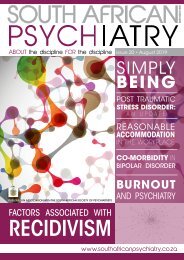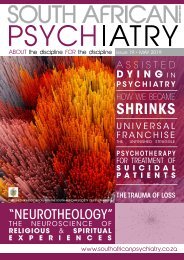South African Psychiatry - February 2019
South African Psychiatry - February 2019
South African Psychiatry - February 2019
You also want an ePaper? Increase the reach of your titles
YUMPU automatically turns print PDFs into web optimized ePapers that Google loves.
REPORT<br />
is focused on neurodevelopmental influences<br />
towards depression and neurodegenerative<br />
diseases studied in animal models.<br />
His seminar was on ‘Brainstem Dysfunction in<br />
Neuropsychiatric Disorders’ such as Alzheimer’s<br />
Disease, Parkinson’s Disease and depression.<br />
Despite the fundamental role of the brainstem in<br />
regulating vital functional abilities such as arousal,<br />
breathing, autonomic nervous system activity as<br />
well as regulating all higher cerebral functions via<br />
neurotransmitter projection systems originating in<br />
the brainstem, the role of the brainstem has received<br />
relatively little attention in most neuropsychiatric<br />
disorders. His seminar reviewed the neuroanatomy<br />
of the brainstem as well as the current status on<br />
findings, derived from a wide range of studies using<br />
molecular, cellular and imaging technologies, of<br />
brainstem involvement in neurodevelopmental (i.e.<br />
autism, schizophrenia) and neurodegenerative<br />
disorders (Alzheimer’s and Parkinson’s disease).<br />
Besides the dorsal and median raphe nuclei<br />
complexes comprising mainly of serotoninproducing<br />
neurons, the brainstem also contains<br />
noradrenalin, dopamine and histamine-producing<br />
nuclei, i.e. the locus coeruleus, the substantia<br />
nigra and the mamillary bodies respectively. The<br />
brainstem is furthermore the relay station of afferent<br />
and efferent projections between the autonomic<br />
nervous system in the peripheral body and higher<br />
cerebral brain regions.<br />
Over the past decades, the incidence of agerelated,<br />
neurological and psychiatric disorders such<br />
as Alzheimer’s disease, Parkinson’s disease, but<br />
also depression has increased considerably. Mood<br />
disorders are strongly related to exposure to stress.<br />
THE HIPPOCAMPUS AND OTHER<br />
FOREBRAIN STRUCTURES ARE THE<br />
APEX OF STRESS HORMONE CONTROL<br />
MECHANISMS AND DAMAGE TO THEM<br />
MAY BE ONE WAY IN WHICH STRESS<br />
HORMONE SECRETION ESCAPES FROM<br />
INHIBITORY CONTROL IN DEPRESSION.<br />
In turn, stress, probably through toxic effects of<br />
glucocorticoids, decreases neurogenesis and<br />
cell survival while antidepressants enhance these<br />
processes in experimental animals. Therefore,<br />
since treatment strategies are not yet available,<br />
primary prevention in these age-related and stressrelated<br />
neurological disorders is of importance.<br />
As mentioned before most of the focus on<br />
neurobiological questions on the above mentioned<br />
diseases are related to forebrain structures since<br />
they are often associated with cognitive dysfunction.<br />
The brainstem is a highly neglected brain area in<br />
neurodegenerative diseases, including Alzheimer’s<br />
and Parkinson’s disease and frontotemporal lobar<br />
degeneration. Likewise, despite a long-standing<br />
recognition of brainstem involvement, relatively few<br />
studies have addressed the exact mechanisms that<br />
underlie brainstem autonomic dysfunction. Improved<br />
insight in the cellular and molecular characteristics of<br />
brainstem function is pivotal to study developmental<br />
origins. In the area of depression, several observations<br />
have been made in relation to changes in one<br />
particular brain structure: the dorsal raphe nucleus.<br />
In addition, dysfunction of the cerebellum is also<br />
observed in Alzheimer’s disease and associated with<br />
pulmonary deregulation. The dorsal raphe nucleus<br />
is also involved in the circuit of stress regulated<br />
processes and cognitive events. In order to gain<br />
more information about the underlying mechanisms<br />
that may govern neurodegeneration, e.g. amyloid<br />
plaques, neurofibrillary tangles, and impaired<br />
synaptic transmission in Alzheimer’s disease, a rat<br />
dissociation culture model was established by Prof<br />
Steinbusch and his colleagues that allows mimicking<br />
of certain aspects of autopsy findings. They observed<br />
a similar phenomenon in brains from patients<br />
suffering from neurodegenerative disease since this<br />
also related to changes in brain derived neurotropic<br />
factor (BDNF) levels. The ascending projections and<br />
multi-transmitter nature of the dorsal raphe nucleus<br />
in particular and the brainstem in general stress its<br />
role as a key target for research into Alzheimer’s and<br />
Parkinson’s disease and autonomic dysfunction.<br />
It also points towards the increased importance<br />
and focus of the brainstem as a key area in various<br />
neurodevelopmental and age-related diseases.<br />
Prof Steinbusch taking questions from the audience.<br />
Profs. Steinbusch and Tremblay with Wits Cortex Club members, students and staff<br />
members.<br />
Tanya Calvey has a background in evolutionary neurobiology and lectures morphological anatomy in the Faculty of Health<br />
Sciences, University of the Witwatersrand. Tanya studies the neuropsychopharmacology of SUDs in humans and animals.<br />
Her research team is multidisciplinary and her research is funded by the <strong>South</strong> <strong>African</strong> Medical Research Council, the<br />
National Research Foundation and the International Society for Neurochemistry. Tanya is also actively involved in developing<br />
neuroscience research in Africa. She is the Secretary of the <strong>South</strong>ern <strong>African</strong> Neuroscience Society and the co-founder of the<br />
Wits Cortex Club. Correspondence: Tanya.Calvey@wits.ac.za<br />
54 * SOUTH AFRICAN PSYCHIATRY ISSUE 18 <strong>2019</strong>
















